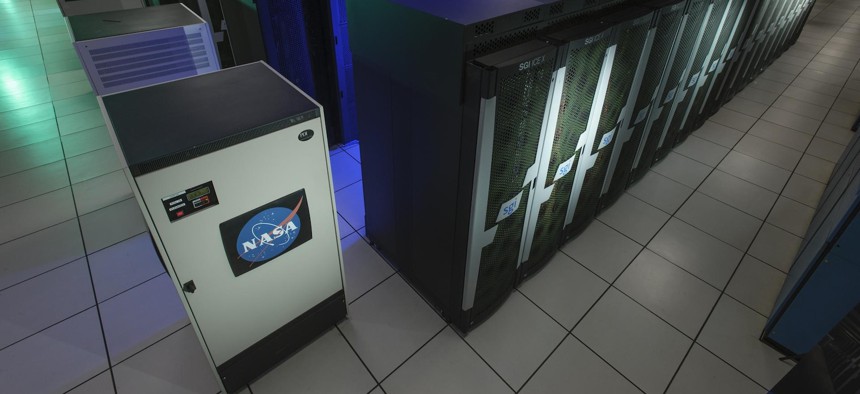NASA needs to refocus on supercomputing to keep pace in space, watchdog says

NASA's Supercomputer Pleiades at the Ames Research Center in Silicon Valley, Calif. NASA photo by Dominic Hart
The space agency “needs a renewed commitment and sustained leadership attention” to enhance its overburdened and vulnerable high-end computing assets.
NASA’s supercomputing capabilities helped the United States win the space race against the Soviet Union, but the agency now needs to emphasize oversight and management of its high-end computing — or HEC — capabilities if it wants to successfully launch future missions, according to a watchdog audit released on Thursday.
The report from NASA’s Office of Inspector General said the space agency “needs a renewed commitment and sustained leadership attention to reinvigorate its HEC efforts” and warned that inaction “is likely to constrain future mission priorities and goals” — such as the Artemis program’s goal of returning U.S. astronauts to the Moon before sending crewed missions to Mars within the next few decades.
OIG’s audit identified several areas of particular concern with NASA’s oversight of its supercomputers, including decentralized management of HEC assets and “oversubscribed and overburdened” resources.
The watchdog found that NASA’s supercomputing resources are “not managed as a program or centralized agency strategic service,” with this disjointed oversight “hindering the agency’s ability to efficiently allocate resources, adapt to varying mission needs and quickly respond to technology advancements.”
This lack of administrative focus, in part, has resulted in NASA “not keeping up with today’s rapid technological developments and specialized scientific and advanced research computing requirements due to funding and organizational constraints.”
OIG noted that the agency’s current HEC infrastructure “is built almost exclusively on cores of central processing units (CPUs), which lack the computational capabilities of the more modern graphics processing units (GPUs) — currently in use within the field worldwide.”
The report warned that the agency’s continued reliance on outdated capabilities — which the audit attributed to supply chain concerns, coding requirements and staffing issues — “will directly impact the agency’s ability to meet its exploration, scientific and research goals.”
This technological stasis is also affecting NASA’s use and development of artificial intelligence capabilities, according to OIG. While NASA is working to expand its AI leadership, the report noted that the agency’s AI personnel are “a primary user of HEC capabilities” and that collaboration with HEC leadership is likely “to prove less fruitful given the limitations of the agency’s HEC organizational structure and capability deficiencies.”
“While HEC can support some small AI projects, the agency’s current HEC ecosystem cannot support projects that require a massive data stream,” the audit said.
OIG also said that lax oversight of the agency’s supercomputing systems resulted in concerning and unnecessary cybersecurity risks, with the report finding “extensive use of NASA’s HEC assets by external and foreign national parties.”
NASA security personnel also expressed concerns to OIG about the lack of user activity monitoring capabilities and their exclusion from the approval and review processes for external users to access the HEC systems or agency datasets.
“As a result, limited cybersecurity practices expose the agency’s HEC resources at a higher risk than necessary,” the report said, noting that “without a refocused effort to implement better cybersecurity safeguards, NASA’s HEC resources will continue to be high-value targets to adversaries — potentially posing risks to not just a singular asset, but to NASA’s network and IT inventory as a whole.”
The audit made nine recommendations to NASA, including for the agency to appoint executive leadership “to determine the appropriate definition, scope, ownership, organizational placement and structure” for its HEC capabilities. OIG also recommended that NASA establish specialized teams to, in part, “identify and mitigate gaps in the foreign national accreditation access process,” evaluate cyber risks and “identify technology gaps essential for meeting current and future needs and strategic technological and scientific requirements.”
NASA concurred with the recommendation to establish executive leadership for its HEC assets and partially concurred with the report’s remaining recommendations, noting that it was working “to collaborate and strategize on the issues identified by the OIG.”
NEXT STORY: Charting Your Path to Modernization






